A ratchet wrench, a common tool found in many toolboxes, is a manual device used for tightening or loosening nuts and bolts. It is designed with a ratcheting mechanism that allows the user to apply force in one direction while freely moving in the opposite direction. This unique feature makes it an indispensable tool for mechanics, builders, and DIY enthusiasts.
The ratchet wrench is not just a tool for professionals; it plays a significant role in everyday tasks. From assembling furniture to repairing bicycles, the ratchet wrench proves its utility. Its ability to fit into tight spaces and the ease of use it offers, even to novices, makes it a must-have tool in every household.
Understanding the ratchet wrench, its evolution, types, and key features can help users make the most of this versatile tool. This article aims to provide a comprehensive guide to ratchet wrenches, their uses, and how to choose the right one.
Our Top Ratchet Wrench Picks
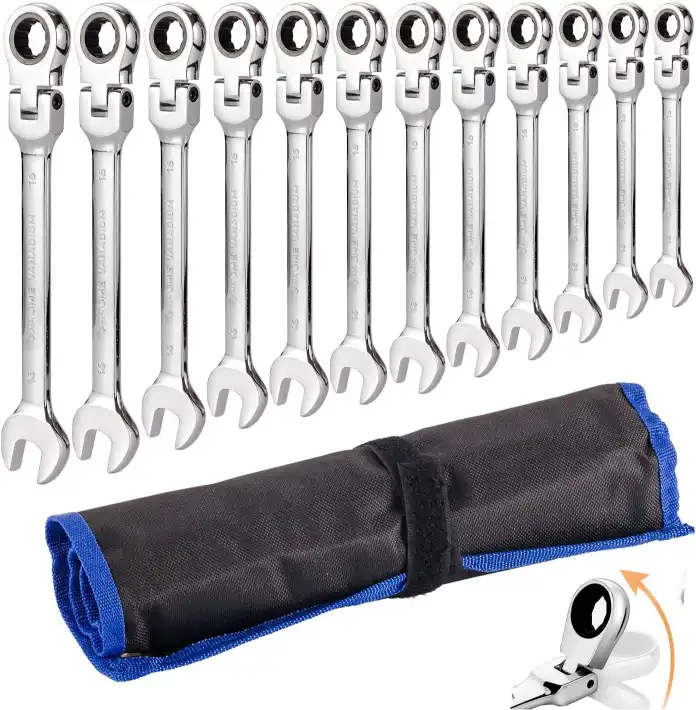
Flexible Ratchet Wrench Set
Check on AmazonKey Specs:
- Sizes Included: 8 mm to 19 mm
- Material: Chrome vanadium steel, mirror polished
- Tooth Count: 72-tooth ratchet (5° swing arc)
- Head Type: 180° Flex-head with open/box-end combo
- Storage: Roll-up pouch included for portability
The precision and flexibility in this Qnkaa 12-piece Flex-Head Ratchet Wrench Set make it a staple in my toolkit. Each wrench feels solid—chrome vanadium steel construction holds up to serious torque, and the 72-tooth ratcheting mechanism engages with minimal swing, ideal for tight engine bays or HVAC units. The 180-degree pivoting head gets into spots straight tools can’t. It’s thoughtfully packaged in a compact roll pouch, making transport and storage a breeze without sacrificing accessibility.
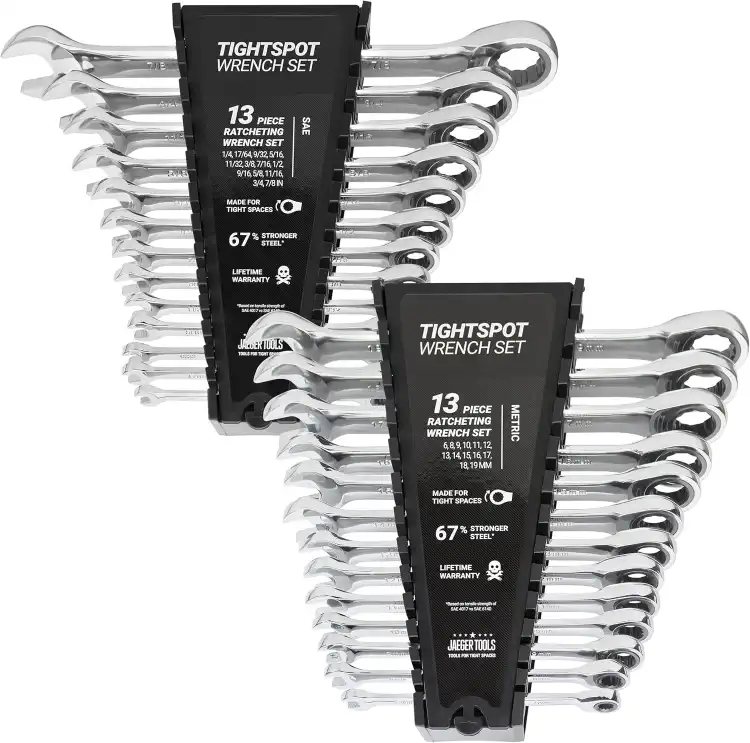
Jaeger 26pc TIGHTSPOT Ratcheting Wrench Master Set
Check on AmazonKey Specs:
- Sizes: 13 SAE (1/4″–7/8″) + 13 Metric (6–19 mm)
- Ratcheting Arc: 4-degree swing with 90-tooth gear
- Material: Aerospace-grade chrome vanadium steel
- Design: Ultra-slim flex heads for tight access
- Storage: Hard tray organizer (no roll-up pouch)
The Jaeger 26pc TIGHTSPOT Ratcheting Wrench Set is one of the most intelligently crafted toolkits I’ve owned. The ultra-slim profile and 4-degree ratcheting swing make tight clearances effortless to handle. Its 90-tooth mechanism delivers buttery-smooth action, and the aerospace-grade vanadium steel holds torque like a beast. I especially appreciate the no-roll tray organizer—quick access, no fumbling. Whether under a car hood or fixing appliances, these wrenches stay locked in and efficient from start to finish.
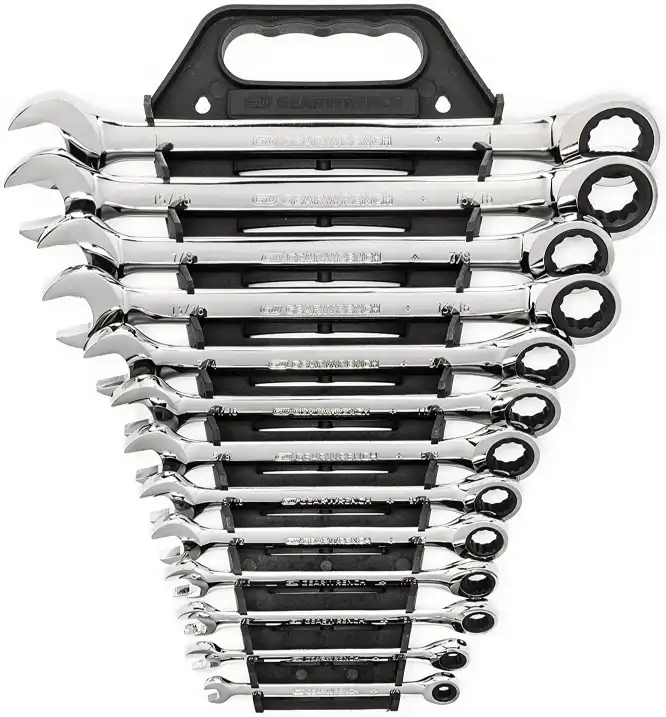
GEARWRENCH 13 Piece 12 Point Ratcheting Combination Wrench Set SAE
Check on AmazonKey Specs:
- Ratcheting Arc: 5-degree swing with 72-tooth gear
- Construction: Alloy steel with thin-profile head
- Grip: Off-corner loading for secure torque
- Size Range: SAE 1/4 inch to 1 inch
- Storage: Includes plastic organizer rack
The GEARWRENCH 13-Piece Ratcheting SAE Wrench Set has been a game-changer in my kit. What stands out most is the 72-tooth ratcheting mechanism—only needing a 5° arc to turn, it makes tight-area work significantly faster. I also appreciate the off-corner loading; it grips bolts securely without rounding them out. The slim head and beam slide into places traditional wrenches just can’t. This is hands-down one of the most efficient, durable sets for anyone serious about precision.
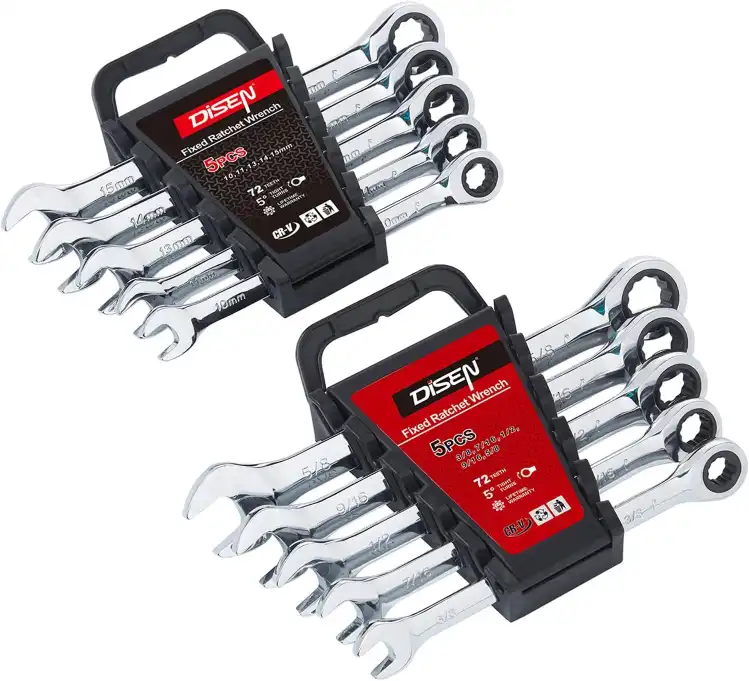
DISEN 10Pcs Ratcheting Wrench Set
Check on AmazonKey Specs:
- Teeth Count: 72-tooth ratcheting system
- Drive Style: 12-point full-drive box end
- Sizes Included: Metric 10–15 mm, SAE 3/8”–5/8”
- Material: Heat-treated chrome vanadium steel
- Storage: Portable organizer bag for easy transport and storage
The DISEN 10-Piece Ratcheting Wrench Set is an excellent value, offering both SAE and metric sizes for versatile use. The 72-tooth ratchet gears are fantastic for tight spaces, providing a minimal 5° swing to get the job done in those awkward spots. The 12-point box end ensures a strong grip, preventing rounding, even on stubborn bolts. Made from durable chrome vanadium steel, this set is built to last and is a must-have for any DIY enthusiast or mechanic.
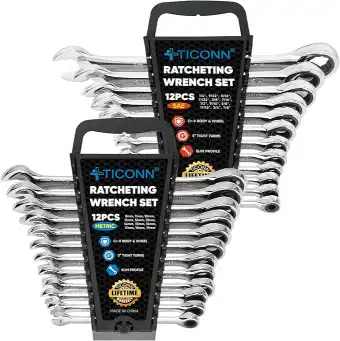
TICONN 24PCS Ratcheting Wrench Set
Check on AmazonKey Specs:
- Material: Chrome Vanadium steel
- Sizes: 12 SAE (1/4″–7/8″) and 12 Metric (8mm–19mm)
- Storage: Compact nylon organizer rack
- Ratcheting Mechanism: Direction marked on both sides
- Warranty: 24-month warranty from TICONN
The TICONN 24PCS Ratcheting Wrench Set is a versatile and durable choice for both professionals and DIY enthusiasts. Crafted from premium Chrome Vanadium steel, these wrenches are resistant to rust and wear. The slim profile is perfect for accessing tight spots, and the stamped size marks ensure easy identification. The set includes both SAE and Metric sizes, making it ideal for various tasks. Plus, the compact organizer rack is an excellent space-saving feature for easy storage and transport.
Understanding the Basics of a Ratchet Wrench
A ratchet wrench is a handheld tool designed to tighten or loosen fasteners, such as nuts and bolts. The key feature of a ratchet wrench is its ratcheting mechanism, which allows the user to apply force in one direction while moving freely in the opposite direction. This feature makes the ratchet wrench an efficient tool, especially in tight spaces where movement is limited.
The ratchet wrench is composed of several parts, each playing a crucial role in its function. The handle is the part held by the user, providing leverage for turning the wrench. The head contains the ratcheting mechanism and the socket that fits over the nut or bolt. The direction lever on the head allows the user to switch the functioning direction of the ratchet.
Understanding the basic parts and functions of a ratchet wrench is the first step towards using it effectively. Whether you’re a professional mechanic or a DIY enthusiast, a good grasp of these basics can help you make the most of this versatile tool.
The Evolution of Ratchet Wrenches
The ratchet wrench has a rich history that dates back to the early 19th century. The first patent for a ratchet wrench was issued in 1863 to J.J. Richardson of the Richardson Manufacturing Company. Over the years, the design and functionality of the ratchet wrench have evolved, making it more efficient and user-friendly.
Technological advancements have played a significant role in the evolution of the ratchet wrench. Modern ratchet wrenches are more compact, durable, and versatile than their predecessors. They come in various sizes and types, with features like flex heads and reversible mechanisms, catering to different needs and applications.
From the simple hand tool of the 19th century to the versatile device of today, the ratchet wrench has come a long way. Its evolution is a testament to human ingenuity and the continuous pursuit of efficiency and convenience in tools and machinery.
Types of Ratchet Wrenches
There are several types of ratchet wrenches available in the market, each designed for specific tasks and applications. Standard ratchet wrenches are the most common type, featuring a fixed head with a ratcheting mechanism. They are ideal for most general applications.
Flex head ratchet wrenches, on the other hand, feature a head that can pivot, allowing for greater maneuverability in tight spaces. Reversible ratchet wrenches have a mechanism that allows the user to switch the ratcheting direction, making them versatile tools. Stubby ratchet wrenches, with their short handles, are designed for use in confined spaces.
Understanding the different types of ratchet wrenches and their uses can help users choose the right tool for their needs. Whether you’re a professional mechanic or a DIY enthusiast, there’s a ratchet wrench that’s right for you.
Key Features to Consider When Buying a Ratchet Wrench
When buying a ratchet wrench, several key features should be considered. The size and weight of the wrench can affect its ease of use and suitability for certain tasks. A wrench that’s too heavy can be difficult to use for extended periods, while one that’s too light may not provide enough torque for heavy-duty tasks.
The material and durability of the wrench are also important considerations. Ratchet wrenches are typically made of steel alloys for strength and durability. However, the quality of the material can vary, affecting the wrench’s lifespan. The ratcheting mechanism, which is the heart of the wrench, should be robust and reliable.
Finally, the handle comfort and grip can significantly impact the user’s experience. A wrench with a comfortable, non-slip grip can make tasks easier and reduce hand fatigue. By considering these key features, buyers can ensure they choose a ratchet wrench that meets their needs and offers good value for money.
Understanding the Ratchet Wrench Sizes
Ratchet wrenches come in various sizes, typically measured by the size of the drive square and the length of the handle. The drive square size determines the type of sockets the wrench can use, while the handle length affects the amount of leverage and reach the wrench can provide.
Standard sizes for ratchet wrenches include 1/4 inch, 3/8 inch, and 1/2 inch, which refer to the size of the drive square. Choosing the right size is crucial as it affects the wrench’s compatibility with sockets and its suitability for certain tasks. For example, a 1/4 inch ratchet wrench is ideal for small, delicate tasks, while a 1/2 inch wrench is better suited for heavy-duty applications.
Understanding the sizes of ratchet wrenches and their implications can help users choose the right tool for their needs. Whether you’re tightening a small nut on a bicycle or loosening a large bolt on a car engine, there’s a ratchet wrench size that’s right for the job.
The Role of Material in Ratchet Wrench Durability
The material of a ratchet wrench plays a crucial role in its durability and lifespan. Most ratchet wrenches are made of steel alloys, known for their strength and resistance to wear and tear. However, the quality of the material can vary, affecting the wrench’s durability.
High-quality ratchet wrenches often use chrome vanadium steel, which offers excellent strength and durability. Some wrenches may also have a chrome or nickel finish to resist corrosion and extend the tool’s lifespan. However, these materials and finishes can add to the cost of the wrench.
When choosing a ratchet wrench, it’s important to consider the balance between cost and durability. A cheap wrench may not last long under heavy use, while a high-end wrench can be a worthwhile investment for those who use the tool regularly. By understanding the role of material in a wrench’s durability, users can make informed decisions when purchasing this essential tool.
Importance of a Good Ratcheting Mechanism
The ratcheting mechanism is the heart of a ratchet wrench, allowing the tool to tighten or loosen fasteners in one direction while moving freely in the opposite direction. This mechanism consists of a gear and a pawl, which engage and disengage as the wrench is turned, creating the ratcheting action.
A good ratcheting mechanism can make tightening and loosening fasteners effortless, saving time and reducing user fatigue. The number of teeth on the gear, known as the tooth count, can affect the wrench’s performance. A higher tooth count allows for smaller ratcheting arcs, making the wrench more efficient in tight spaces.
When choosing a ratchet wrench, it’s important to consider the quality and design of the ratcheting mechanism. A poorly designed mechanism can make the tool difficult to use and reduce its lifespan. On the other hand, a high-quality ratcheting mechanism can make the wrench a pleasure to use and a valuable addition to any toolbox.
The Significance of Handle Comfort and Grip
The design of a ratchet wrench’s handle can significantly impact user comfort and the efficiency of the tool. A well-designed handle should fit comfortably in the hand, allowing the user to apply force effectively. The handle should also provide a good grip to prevent the wrench from slipping during use.
Many ratchet wrenches feature ergonomic handles designed to reduce hand fatigue during prolonged use. Some handles may also have a rubber or plastic coating to provide a non-slip grip. However, these features can vary among different wrench models and brands.
When choosing a ratchet wrench, it’s important to consider the comfort and grip of the handle. A wrench with a comfortable, non-slip handle can make tasks easier and more enjoyable, whether you’re a professional mechanic or a DIY enthusiast.
Top Ratchet Wrench Brands
There are many brands of ratchet wrenches available in the market, each offering different features and benefits. Some of the top brands include Craftsman, known for their durable and reliable tools; Snap-On, renowned for their high-quality, professional-grade tools; and Stanley, which offers a wide range of tools at affordable prices.
Each of these brands offers a variety of ratchet wrenches, from standard to flex head models, in various sizes and materials. When comparing these brands, it’s important to consider the key features of their wrenches, such as the size, material, ratcheting mechanism, and handle design, as well as the price.
Choosing a ratchet wrench from a reputable brand can ensure you get a high-quality tool that meets your needs and offers good value for money. Whether you’re a professional mechanic or a DIY enthusiast, there’s a ratchet wrench brand that’s right for you.
Price Range of Ratchet Wrenches
The price of ratchet wrenches can vary widely, depending on the brand, size, material, and features of the wrench. On average, a standard ratchet wrench can cost anywhere from $10 to $100 or more. High-end models from premium brands can cost several hundred dollars.
Several factors can affect the price of a ratchet wrench. The size and material of the wrench can influence its cost, with larger wrenches and those made of high-quality materials typically costing more. Features like a flex head or a reversible mechanism can also add to the price.
When buying a ratchet wrench, it’s important to consider not only the price but also the value the tool offers. A cheap wrench may not last long or perform well, while a more expensive wrench can be a worthwhile investment if it’s durable, reliable, and meets your needs.
How to Maintain a Ratchet Wrench
Maintaining a ratchet wrench is crucial to ensure its longevity and optimal performance. Basic maintenance includes cleaning the wrench after use to remove dirt and grime, which can interfere with the ratcheting mechanism. Lubricating the mechanism periodically can also help keep it operating smoothly.
It’s also important to store the wrench properly when not in use. Keeping the wrench in a dry, cool place can help prevent rust and corrosion. If the wrench comes with a case or pouch, it’s best to use it for storage to protect the tool from damage.
Regular maintenance of a ratchet wrench can extend its lifespan and ensure it’s always ready for use. Whether you’re a professional mechanic or a DIY enthusiast, taking care of your tools can save you time and money in the long run.
Safety Precautions When Using a Ratchet Wrench
Using a ratchet wrench safely is crucial to prevent accidents and injuries. Some safety precautions to follow include wearing protective gloves to protect your hands, ensuring the wrench and socket are properly engaged before applying force, and not using a pipe or other extension on the wrench handle to increase leverage, as this can damage the tool and pose a safety risk.
It’s also important to use the right size of wrench and socket for the task. Using a wrench or socket that’s too large or small can result in the tool slipping, potentially causing injury. Finally, always keep your work area clean and free of clutter to reduce the risk of accidents.
Following these safety precautions can help ensure a safe and productive work experience with your ratchet wrench. Whether you’re a professional mechanic or a DIY enthusiast, safety should always be a top priority when using tools.
Conclusion
The ratchet wrench is a versatile and indispensable tool in many toolboxes. Understanding the basics of a ratchet wrench, its evolution, types, and key features can help users make the most of this tool. Whether you’re a professional mechanic or a DIY enthusiast, there’s a ratchet wrench that’s right for you.
When choosing a ratchet wrench, consider the size, material, ratcheting mechanism, and handle design, as well as the brand and price. A good ratchet wrench should be durable, reliable, comfortable to use, and offer good value for money. With the right ratchet wrench, tightening and loosening fasteners can be a breeze.
Remember to maintain your ratchet wrench properly and follow safety precautions when using it. A well-maintained and safely used ratchet wrench can serve you well for many years. Happy wrenching!
FAQ
What is a ratchet wrench?
A ratchet wrench is a handheld tool designed to tighten or loosen fasteners, such as nuts and bolts. It features a ratcheting mechanism that allows the user to apply force in one direction while moving freely in the opposite direction.
What are the different types of ratchet wrenches?
There are several types of ratchet wrenches, including standard, flex head, reversible, and stubby ratchet wrenches. Each type is designed for specific tasks and applications.
What should I consider when buying a ratchet wrench?
When buying a ratchet wrench, consider the size, material, ratcheting mechanism, and handle design, as well as the brand and price. A good ratchet wrench should be durable, reliable, comfortable to use, and offer good value for money.
